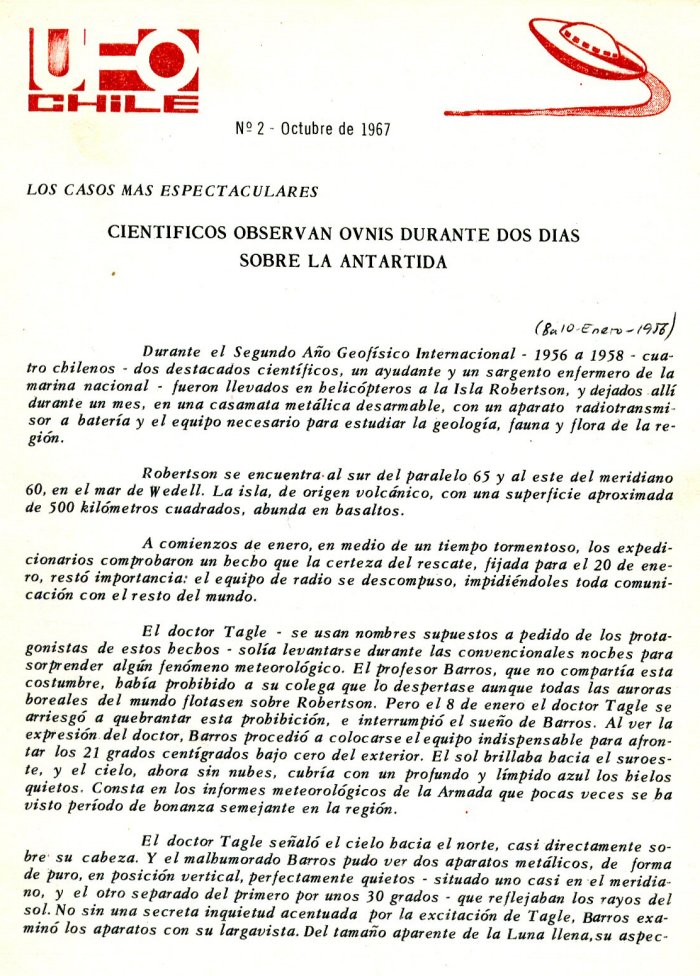No. 1 1 2 3 4 5 6 7 8 > No. 3 No. 4

|
Transcription translated in English:
No 2 - October 1967
THE MOST SPECTACULAR CASES
SCIENTISTS OBSERVE UFOs FOR TWO DAYS IN THE ANTARCTIC
(January 8 to 10, 1956)
During the second international geophysical year - 1956 to 1958 - four Chileans - two prominent scientists, a warrant officer and a Navy sergeant paramedic - were taken by helicopter to Robertson Island, where they stayed for a month, in a dismountable metal casemate, with a radio transmitter running on battery and the necessary equipment to study the geology, fauna and flora of the region.
Robertson Island lies south of the 65th parallel and east of the 60th meridian on the Wedell Sea. The island, of volcanic origin, with an approximate area of 500 square kilometers, abounds in basalt.
At the beginning of January, in the middle of a storm, the expeditionaries found that the certainty of their return, set for January 20, was diminishing: the radio equipment had broken down, preventing them from communicating with the rest of the world.
Dr. Tagle - pseudonyms are used at the request of the protagonists of these events - stood up during the conventional nights to observe meteorological phenomena. Professor Barros, who did not share this habit, had forbidden his colleague to wake up for each and every aurora borealis that floated on Robertson Island, but on January 8, Dr. Tagle had violated this prohibition, interrupting his sleep and that of Barros. Seeing the doctor's expression, Barros set out to turn on the equipment needed to cope with the 21 degrees Celsius below zero outside. The sun was shining to the southeast, and the sky, now cloudless, covered the still ice with its deep, clear blue. It is recorded in Navy weather reports that such good weather has rarely been seen in the area.
Dr. Tagle pointed at the sky to the north, almost directly above his head. And Barros, in a bad mood, could see two metal craft, of pure shape, standing still - one located almost at the meridian, and the other separated from the first by about 30 degrees - which reflected the sun's rays. Not without a secret agitation accentuated by Tagle's excitement, Barros examined the craft with his telescope. Of the apparent size of the Moon, their aspect
Transcription in Spanish:
No 2 - Octubre de 1967
LOS CASOS MAS ESPECTACULARES
CIENTIFICOS OBSERVAN OVNIS DURANTE DOS DIAS SOBRE LA ANTARTIDA
(8 a 10 de Enero, 1956)
Durante el Segundo Año Geofísico Internacional - 1956 a 1958 - cuatro chilenos - dos destacados científicos, un ayudante y un sargento enfermero de la marina nacional - fueron llevados en helicópteros a la Isla Robertson, y dejados allí durante un mes, en una casamata metálica desarmable, con un aparato radiotransmisor a batería y el equipo necesario para estudiar la geología, fauna y flora de la region.
Robertson se encuentraa sur del paralelo 65 y al este del meridiano 60, en el mar de Wedell. La isla, de origen volcánico, con una superficie aproximada de 500 kilómetros cuadradas, abunda en basaltos.
A comienzos de enero, en medio de un tiempo tormentoso, los expedicionarios comprobaron un hecho que la certeza del rescate, fijada para el 20 de enero, restó importancia: el equipo de radio se descompuso, impidiéndoles toda comunicación con el resto del mundo.
El doctor Tagle se usan nombres supuestos a pedido de los protagonistas de estos hechos - solía levantarse durante las convencionales noches para sorprender algún fenómeno meteorológico. El profesor Barros, que no compartía esta costumbre, había prohibido a su colega que lo despertase aunque todas las auroras boreales del mundo flotasen sobre Robertson, pero el 8 de enero el doctor Tagle se arriesgó a quebrantar esta prohibición, e interrumpió el sueño de Barros. Al ver la expresión del doctor, Barros procedió a colocarse el equipo indispensable para afrontar los 21 grados centígrados bajo cero del exterior. El sol brillaba hacia el suroeste, y el cielo, ahora sin nubes, cubría con un profundo y límpido azul los hielos quietos. Consta en los informes meteorológicos de la Armada que pocas veces se ba visto período de bonanza semejante en la región.
El doctor Tagle señaló el cielo hacia el norte, casi directamente sobré' su cabeza. Y el malhumorado Barros pudo ver dos aparatos metálicos, de forma de puro, en posición vertical, perfectamente quietos - situado uno casi en el meridiano, y el otro separado del primero por unos 30 grados - que reflejaban los rayos del sol. No sin una secreta inquietud acentuada por la excitación de Tagle, Barros examinó los aparatos con su larga vista. Del tamaño aparente de la Luna llena su aspec-